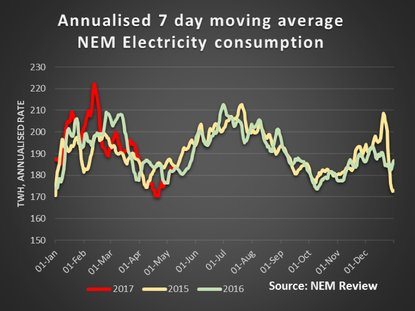The Four Corners program Power Failure added to the sense of crisis around our power system, beginning with the breathless comment that there was almost a breakdown of civil order in South Australia when the lights went out in September. The program looked at the difficulties experienced when the power went off for three days. Recently in some places affected by Cyclone Debbie, crews couldn’t get in to start fixing for about double that time. I’ll come back to Four Corners via a series of articles published on the same day.
First, in the AFR tucked away on page 8, Mark Ludlow penned an article Renewables, EIS ‘make gas-fired power redundant’ (paper edition title). Ludlow interviewed Professor Frank Jotzow, director of the Centre for Climate Economics and Policy at ANU, who said gas had been overtaken by renewable energy, including battery storage, in the transition away from coal-fired power. We should skip gas and go straight to renewables with batteries.
Jotzo favours an emissions intensity scheme (EIS).
At RenewEconomy the lead article was Origin stuns industry with record low price for 530MW wind farm.
- Origin Energy has set a stunning new benchmark for renewable energy off-take deals in Australia – and sounded the alarm for energy incumbents – after committing to a long-term power purchase agreement of below $60/MWh for the 530MW Stockyard Hill Wind Farm in Victoria.
Giles Parkinson told Patricia Karvelas on RN Drive that the wholesale price was quoted as below $60 and was probably $55/MWh, or half the current market price. He said that the cost of wind had halved in the last 6-12 months. It now beats new-build coal or gas, and existing gas.
The plant would be finished in two years, and the futures prices were starting to reflect the reduced price of renewables.
Next, we look at the AFR’s last page article, linked on the front page, by Matthew Stevens Energy crisis ‘tipping point’ passed.
- Glencore has warned that Australia has drifted past a “tipping point” of industrial energy “demand destruction” and that the nation has 12 months to re-establish reliability and affordability of its base load power capacity or risk permanent and unpredictable shifts in the shape of the economy.
That was from global coal boss Peter Freyberg, Glencore’s most senior executive based in Australia. He appeared to be threatening that decisions may have to be made about Glencore’s copper mining and processing operations in Mt Isa and Townsville. He said that “When plants shut down, they don’t come back.”
If you check RenewEconomy’s NEM Watch, it’s mostly coal and gas, even during the day, although rooftop solar’s presence is quite obvious during most days, and frequently exceeds SA’s wind.
There was also some blunt advice from Jean-Sebastien Jacques, CEO of Rio. They sourced 86% of energy for their Boyne Island aluminium smelter themselves, but had to let the rest go and sack 100 people because they couldn’t source suitably priced power.
The article also quoted average spot price of electricity in Queensland through the March quarter as $173.98 a megawatt hour in 2017, as against $80 in 2016. Electricity peaked on 44 separate occasions in Queensland at the market maximum of $14,000/MWh with many of those peaks the result of generators removing capacity and then re-bidding back into the system. Jacques said it was a problem of regulation, not capacity. Government-owned generators were gaming the system as much as their capitalist mates elsewhere.
It is curious then to look at Know your NEM: 5.6GW of new wind and solar under construction by David Leitch at RenewEconomy. 5.6GW is about three times Hazelwood.
Consumption has settled down in the autumn after severe peaks early in the year, as shown in this graph:

This is the comment about future prices:
- For the first time in a year there was a visible reduction in NSW futures prices as compared to four weeks ago, with most other States essentially flat. NSW is the balancing market in the NEM, a net importer from both Qld and Vic and so it’s where we expect the underlying balancing price to show up. Still futures prices remain about $85 MWh even in 2020. To us this seems about the right price longer term as we head to a high renewable future. The key question is what impact is the 13TWh of new supply under construction going to have on price? (Emphasis added)
Parkinson had another article Redflow resumes battery storage deliveries, scores biggest sale. Deliveries had been paused for two weeks while they solved a problem with impurities. The big news, however, is that they scored an A$800,000 contract for multiple sites in the Pacific Islands, where hybrid power is being designed by a New Zealand outfit.
There was a range of other projects reported at RenewEconomy on the day, including a solar farm at Collinsville in Central Queensland. Two significant elements were the use of the closed coal power station infrastructure, I assume to transmit the power, and the contract with Alinta to buy the power produced until 2030.
With the above in mind, the ABC Four Corners report looked a bit long on alarmism. Certainly, the achievement of policy, or policy neglect in Australia to move us from the cheapest energy country in the OECD (so it was said) to now 26th is gobsmacking and a story that needs to be told. The program did talk about renewables, batteries and such, but could have benefited from an interview with the likes of Frank Jotzo or perhaps Giles Parkinson, who sees the future happening before our eyes.
Revealed was the fact that the Turnbull government had been moving towards an EIS before Turnbull slapped the idea down after Josh Frydenberg aired it. Frydenberg’s subsequent statement that it was never a consideration shows him as a person whose word cannot be taken at face value. In other words, he can tell bare-faced porkies when the situation demands.
There were mistakes and omissions that would have made a difference to the tenor of the program. An attempt was made to equally blame both sides of politics. Insufficient weight was given to what the Gillard government achieved with the Greens, with input from Prof Ross Garnaut, and what the situation might be had not the Abbott-Turnbull governments been so determined to undo all that good work.
However, both sides still see gas as a transition base-load fuel, and rate it as cleaner than coal. In the post Gas has got to go we heard that ‘fugitive’ emissions from methane production are not measured in Australia. We assume the standard the United States uses, which is itself questionable. If gas power is to have a net climate benefit compared to coal power, fugitive methane emissions must be less than 3 to 4% of production. Studies have shown that coal seam gas in the USA leaks 1.8 to 3.5 times as much as the official figures would have us believe.
The program accurately reported the universal support for emissions trading, apart from the Turnbull government.
Laura Tingle reports that Turnbull during the summer break spent the time boning up on all sorts of technology. In March when Turnbull was asked about the widespread push for an EIS as a long-term price signal to create investment certainty he said:
- “There’s the point. An emissions intensity scheme would deliver, if that was its objective, would deliver more gas fired power. Where’s the gas? And at what price? You know, adhering to a particular model, a particular technique is easy to do – it’s easier to put it into a headline.” It doesn’t however, deliver the security, affordability and greenhouse gas reductions that the government has set as its three policy goals.
Tingle says a ‘senior source’ told her:
- “Unless you move into a really massive gas reservation model, which you can’t do retrospectively, it’s not going to stack up.”
There may be gas pipelines in the budget infrastructure spend, and Queensland has now seen a second investment in new gas in the Surat Basin with Arrow drilling 180 new wells west of Dalby. However, Turnbull may be the politician in the two major parties closest to the views of Jotzo.
The next major development is the tabling of the Finkel National Electricity Market review, due on 9 June. It remains to see what he comes up with and what political capital Turnbull has to work within his own tribe. Meanwhile new AEMO CEO Audrey Zibelman says clinging to old energy business models is “insane”.
We may be reaching an energy system ‘tipping point’ in a positive sense. Hope lives!


Looks like the feds think gas is the answer. States who insist on blocking gas developments wont get funds.
Look, Victoria has oodles of undersea gas out in Bass Strait, comes ashore in pipes at Longford. Main destination: maufacturers, hospitals and homes in Melbourne. Also some piped ashore near Koo Wee Rup, Lang Lang.
It’s ‘fracking’ for coal seam, or other unusual gas sources that Vic Govt has blocked.
Bass Strait gas is booming.
Ambigulous, Victoria has blocked exploration for conventional gas on land, as well as unconventional, which is hard to fathom. Not sure it matters.
John, it’s hard to know what to make of what they’ve funded and not funded. If the alarmists are to be believed, the Abbott/Turnbull government will have seen the destruction not only of the car industry, but most of the rest of manufacturing on their watch. They are not reacting as though there was a genuine emergency
When I wrote this post, Giles Parkinson’s excellent piece Coalition backtracks on Paris deal, ABC cuts corners on energy appeared later in the day.
He says, more eloquently than I, that the ABC interviewed the wrong people, and basically missed the point. No-one in industry is going to build new coal, and new gas is too expensive. We don’t need batteries in the system until renewables get to 40%, and by the time we get there batteries will be competitive.
The most secure system in the long run is a decentralised system based on renewables. AGL, Origin and the new AEMO boss Audrey Zibelman know that.
About time somebody told the government.
Thank you, Brian.
In Victoria the “Lock the Gate” campaign in rural areas against CSG and particularly fracking, has been very strong and ultimately successful. Andrews Govt very cautious about Parlt seats outside Melbourne.
The campaign stickers are as widespread as the “No Dams” flurry before the Franklin decision, early 80s.
It may not make much sense to ban conventional gas, but Mr Andrews doesn’t need blockades by protestors in Gippsland again.